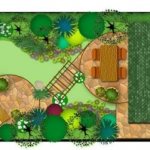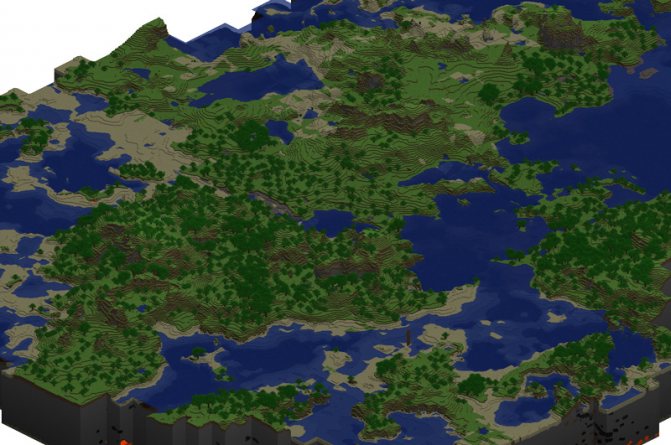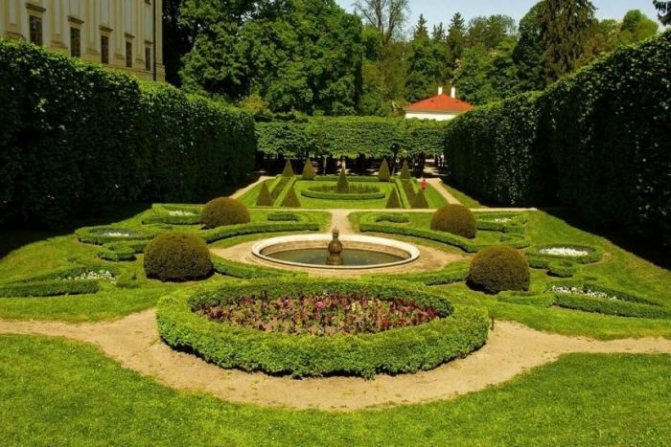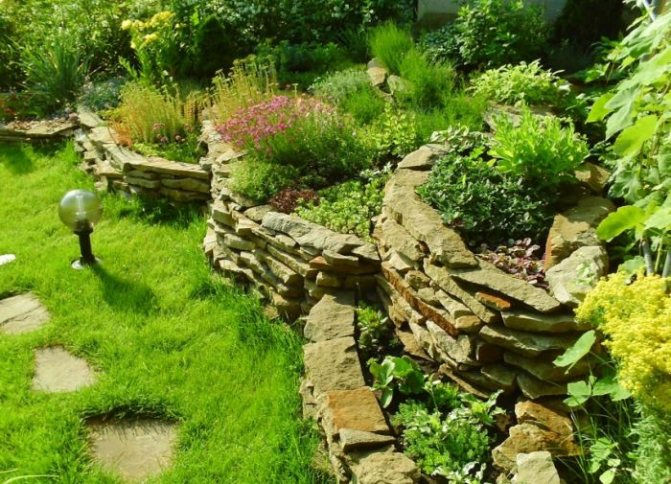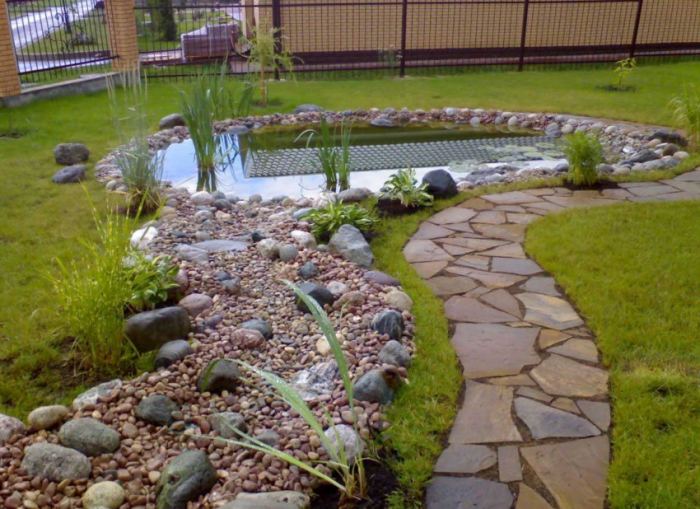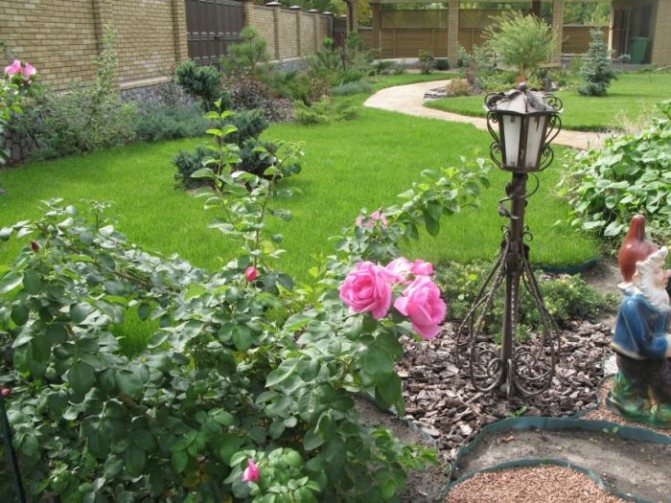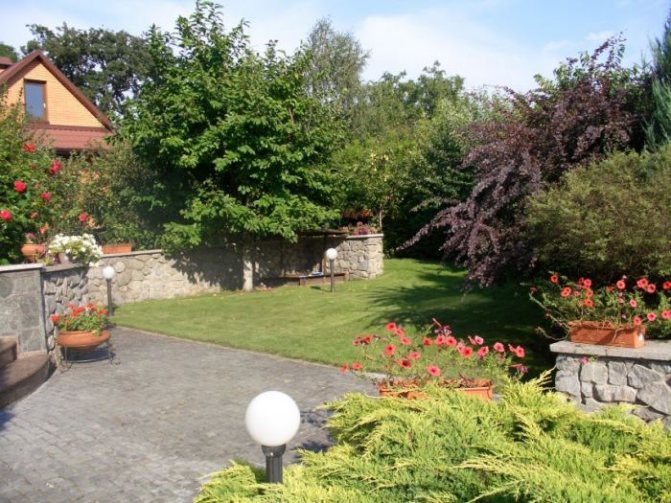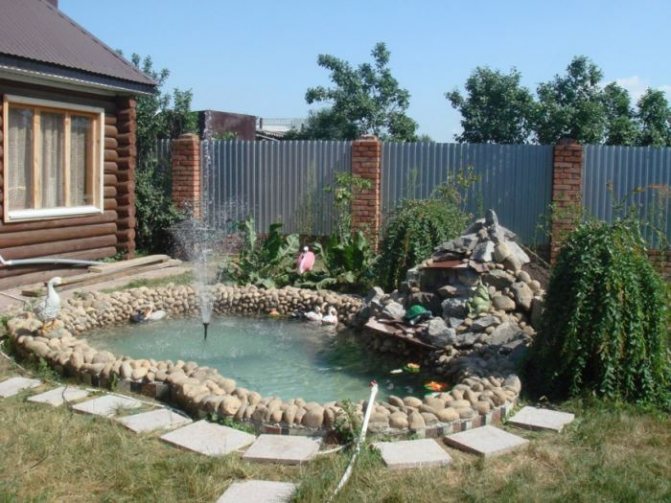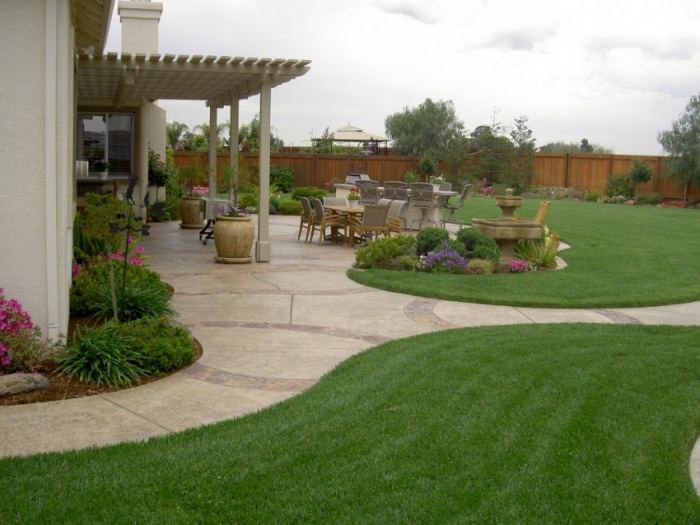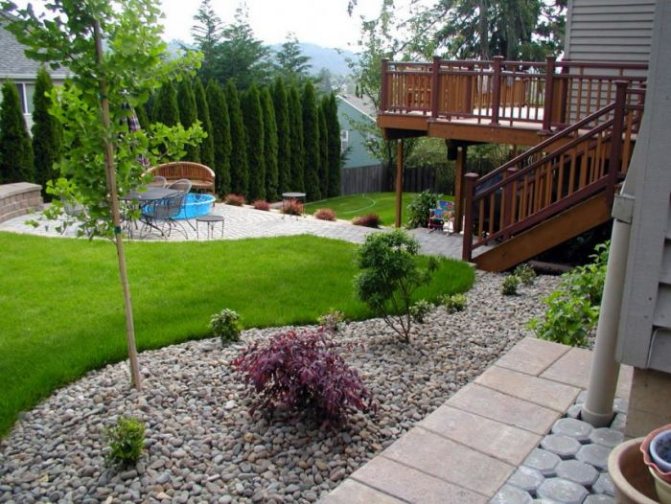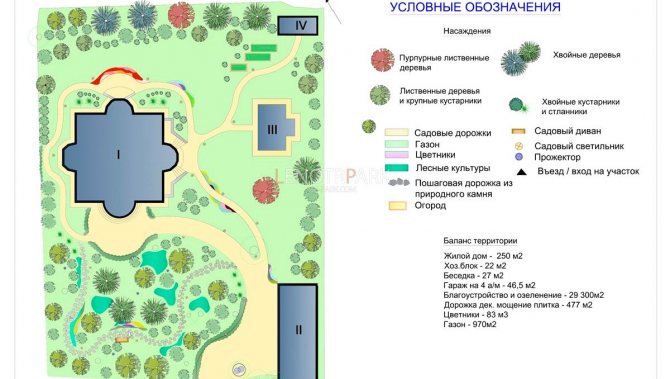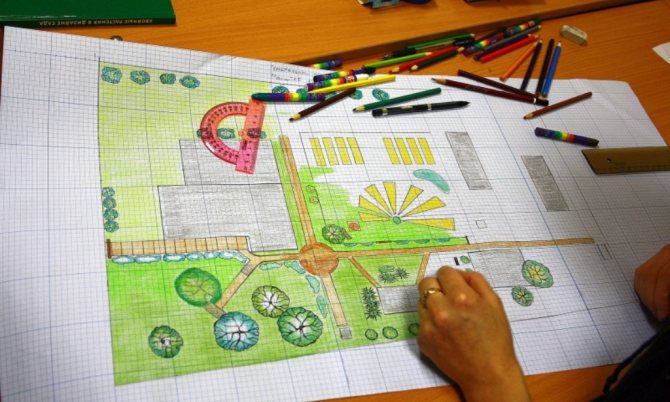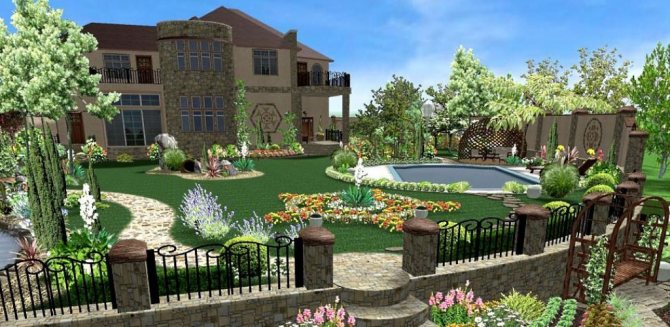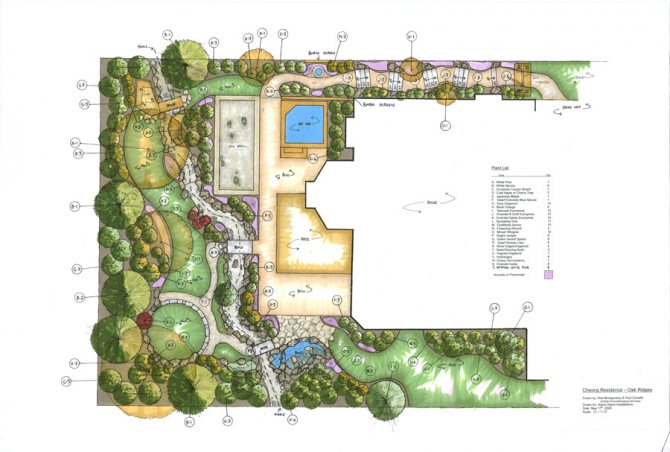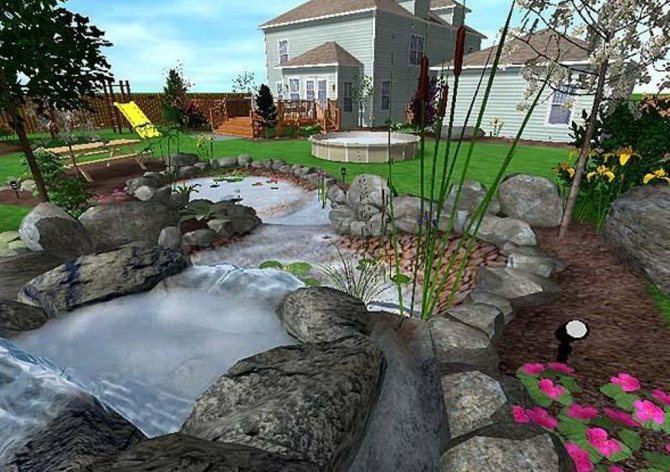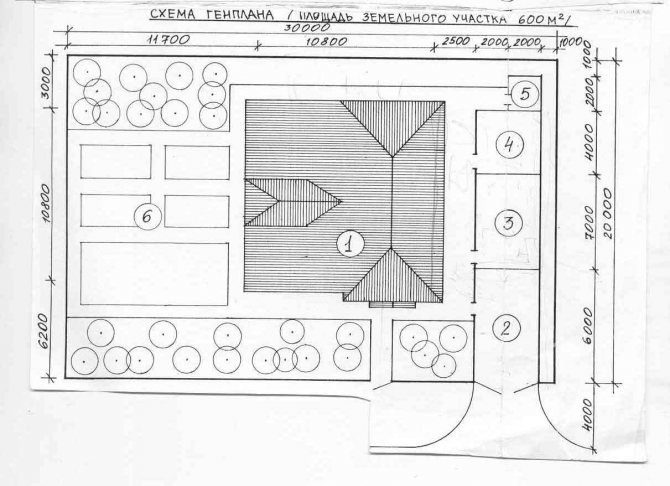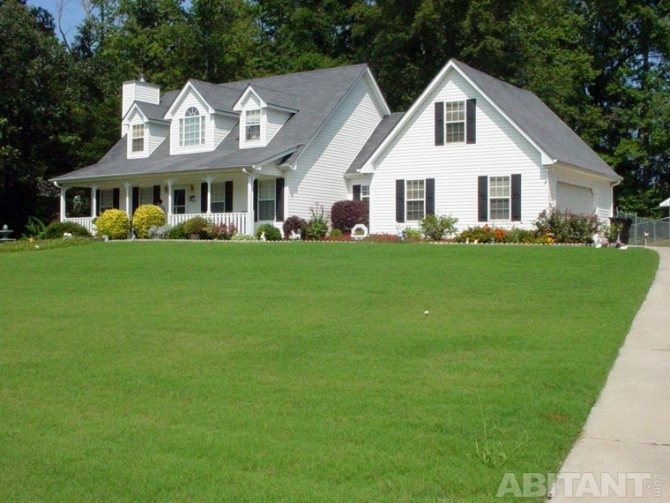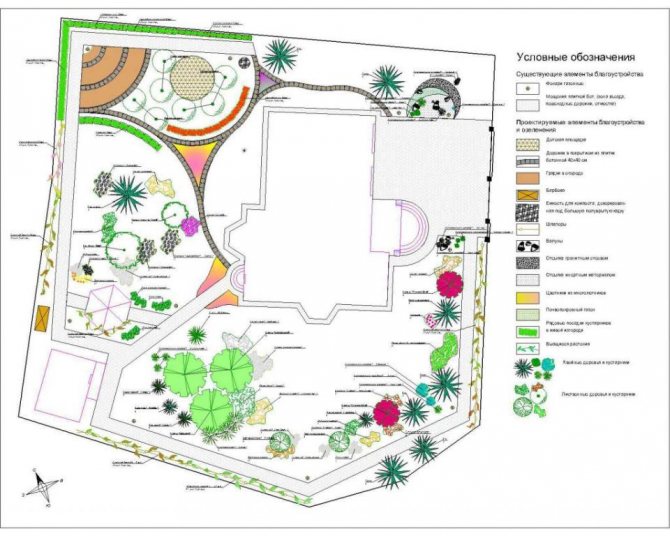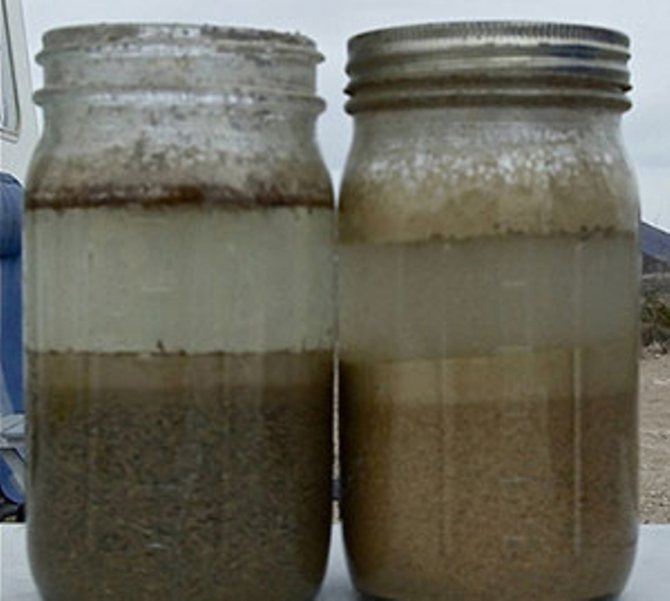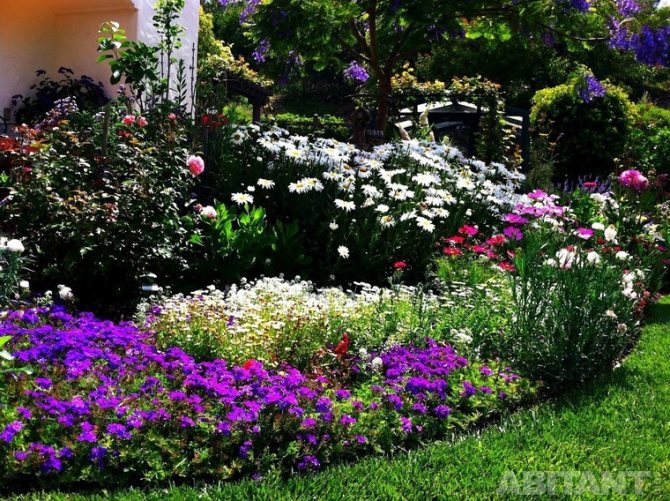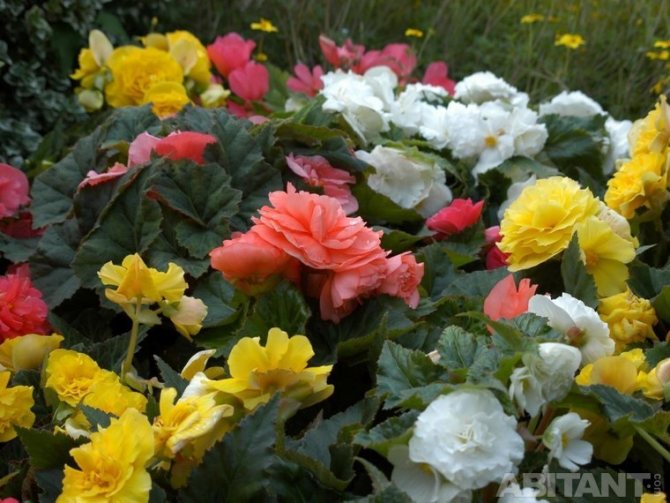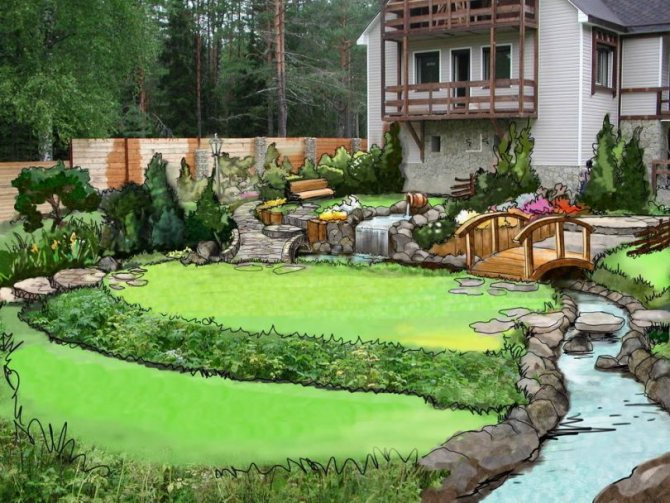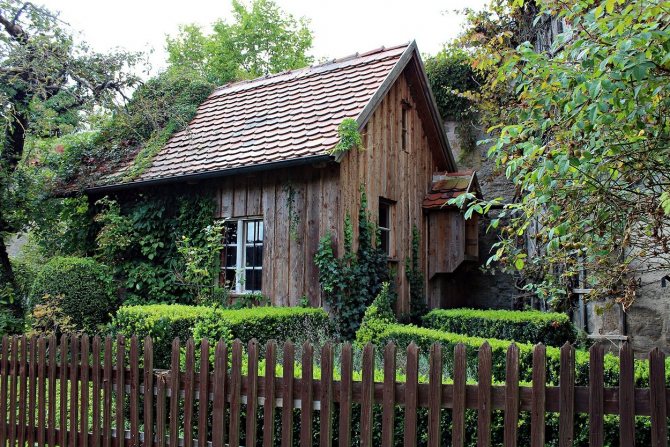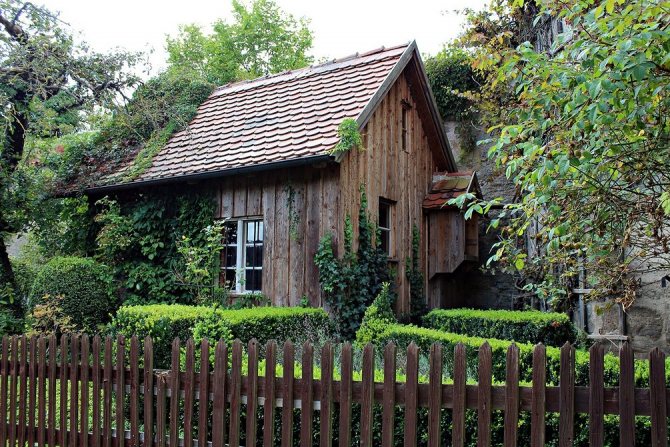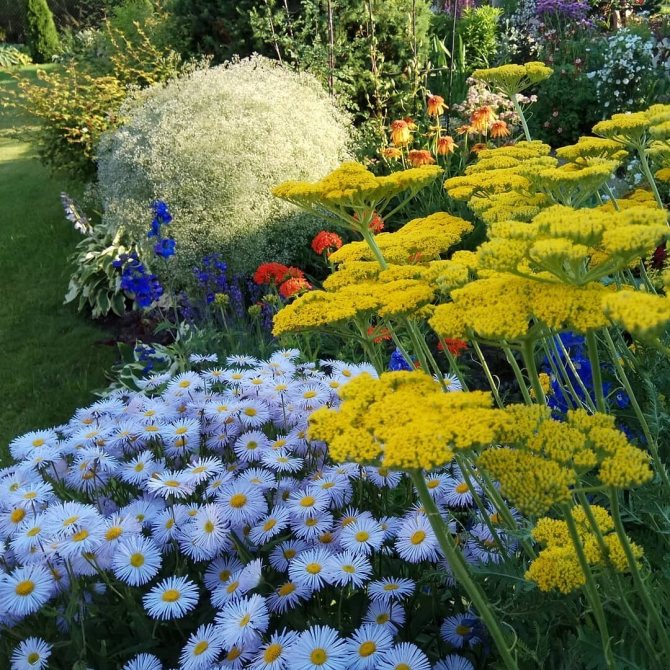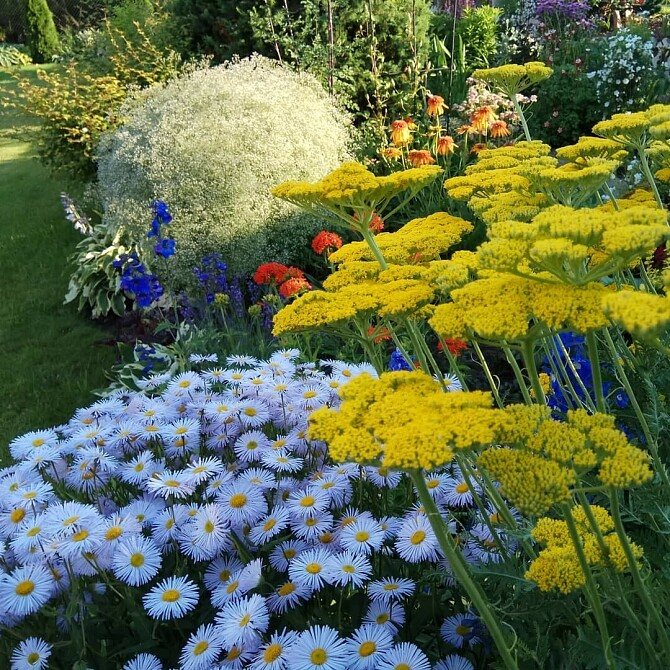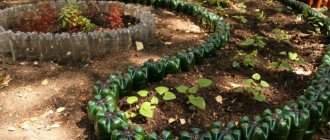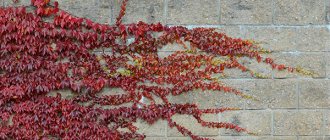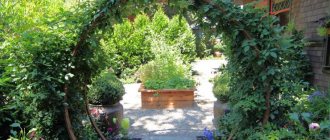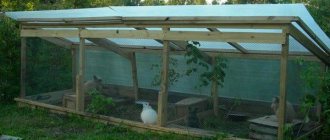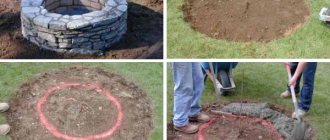Garden beds are gradually being replaced from summer cottages and household plots. If they are, then in small quantities and somewhere in the depths. The main place is occupied by flower beds, recreation areas and other beautiful corners. All this together is called landscape design and is taught at the institute. But if you are not going to make money by arranging, landscaping and decorating yards and dachas, you can try to plan everything yourself. Landscaping with your own hands is a long and difficult business, but extremely exciting: it is very pleasant to look at the beauty created with your own hands.
Where to begin
- 6.1 Flowers in decoration
As usual, you need to start with a plan. You can draw it on graph paper on a scale, or you can use design programs. The most convenient Realtime Landscaping Architect and Sierra Land Designer 3D 7.0. In them, all the images will be three-dimensional and you can really appreciate how your site will look. And even if, few people stick to the plan exactly. But while you draw, you will develop certain skills in landscape design that will help you bring your plans to life.
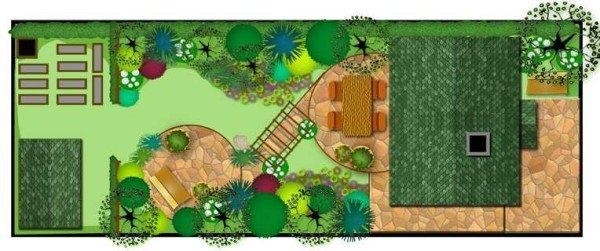
Rectangular plot: landscape design plan
If the site is still empty, think over all the little things: where the entrance will be, how the house, toilet, and other buildings will be located on the site. After drawing all the buildings, draw the paths. Straight lines are rarely done - they are harder to beat in the landscape. Curved, flowing lines will help you organize interesting spots and landings. Do not forget about communications on the plan - water supply, sewerage, irrigation system, etc. Then gradually add elements of landscape design, drawing their details.
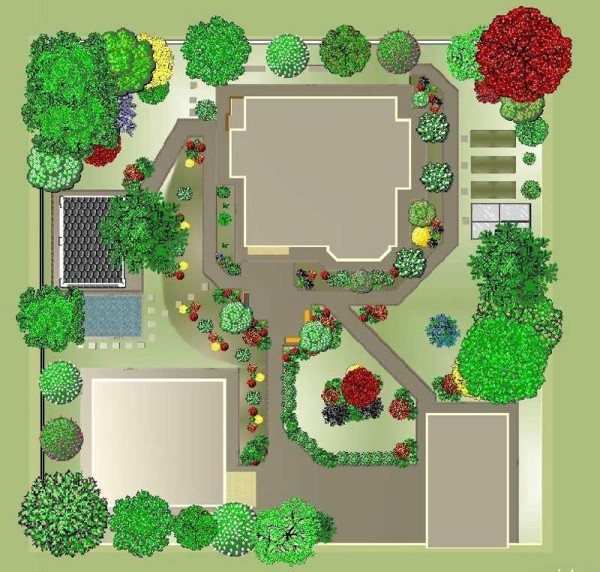

Landscaping plan of a square plot of a country house
If you will equip an already inhabited dacha or courtyard, apply everything that already exists as accurately as possible. To do this, you will have to crawl around the site with a tape measure: first sketch out a site plan and write down the measured distances on it. Then the plan will have to be adjusted according to the measurement results. We got the plan that you have. We have to work on it.
Try to immediately draw those changes that you have planned, because you have something in mind. If you like the result, you can implement it. If not, change the shape first, or figure out where you can move it to make it look better. That is why it is more convenient to work with programs: you see what needs to be changed and how these changes affect the design of the site.
Just one moment. Not everything that looks good on the screen also looks good in life. And it also happens the other way around - it does not look "very good" to the plan, but what is brought to life is simply bewitching. In any case, you will have to make adjustments more than once ...
Landscaping rules
The main task of the site design is to create a harmonious landscape. If so, then you have to take into account the basic laws and observe proportions. One of the main laws that are used in the development of any design, including in landscape design, is the law of the triangle or the golden section.
As applied to our case, it can be interpreted as follows: in order for the landings to look beautiful, it is impossible that the same elements are present in them. For example, dividing a flower bed into zones.Often three different areas are distinguished, but it is not worth making them the same area: one is the largest and two are smaller, but also of different sizes. Also, one color should be primary, the other two should be secondary. And one of the additional - generally in a small amount. This also applies to the choice of plants, both their color and shape, size.
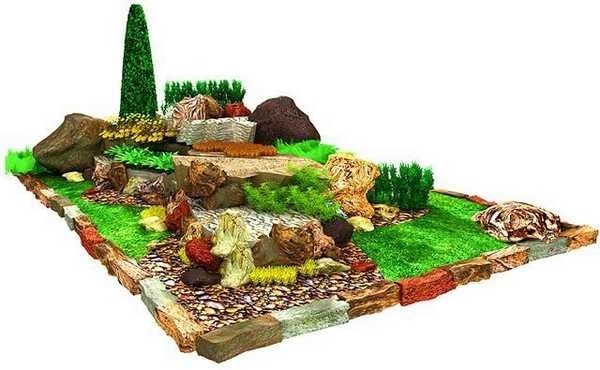

Layout of the site design, taking into account the laws of landscape design
This rule is true not only for flower beds and flower beds, but in general for design: the number and size of zones on the site, design of paths, etc.
When creating a landscape design with your own hands, you must adhere to the law of the circle. It defines harmonious color combinations (see photo). If you divide it in half with a vertical line, there will be warm shades on the right, cold shades on the left. The main compositions are made in one group of colors - cold or warm.
This does not mean that colors from different parts cannot be mixed. It is possible, but the color from the opposite group should be present as an accent that attracts attention. Such contrasting compositions are made if it is necessary to distract attention from something (fence, toilet, etc.).
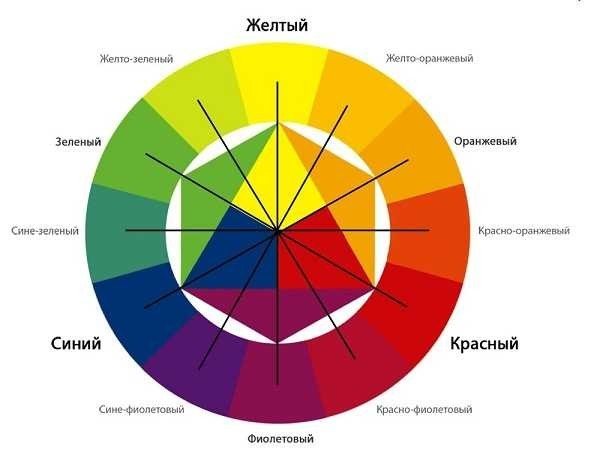

The color wheel is used to define a related color palette
There is also the law of the square. It is difficult to adhere to it in a small dacha or courtyard, but it influences the rules for the location of buildings and planting of plants. Its essence is in orientation to the side of the world. For example, when choosing a place for a house, remember that if you put it on the south side, almost the entire site will be in the shade. In some regions this is good, in some it is bad. You decide for yourself.
The position in relation to parts of the world is taken into account when planning recreation areas. For example, it is better to make a pool just on the south side: the water must be warmed up. But there should be a shaded area, a shed, a pergola nearby, where you can take a break from the hot sun.
In relation to planting plants and determining a place for a garden, it can be interpreted as follows: the tallest plants should be in the north (if you do not live in the south and you do not need shade). Then the rest of the space will be well lit.
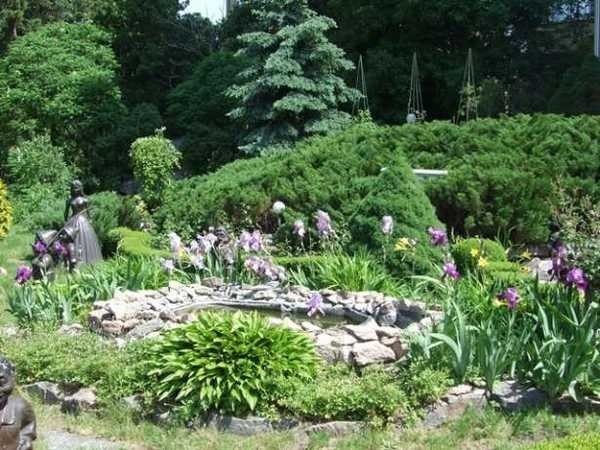

Correct planting of plants in height relative to the cardinal points
Landscaping of a summer cottage or courtyard of a private house requires knowledge of what degree of illumination a particular type of plant prefers. There are always more and less shaded areas. There is always more shadow on the north side of the buildings. Here you need to plant shade-tolerant trees, shrubs, flowers. Already at a distance of two to three meters, the zone may have good illumination, since the shadow from the house may no longer reach there. Here you will need plants that love the abundance of light.
Create a plan for the location of zones and buildings, taking into account these rules. There are many more, but even if you take these three into account, your design will be competent, and, what is important, beautiful and harmonious.
Modification of the diamond-square algorithm for large maps
And finally, a few words about my implementation of the diamond-square algorithm. The main question that you ask yourself when generating a landscape is how to make it so that you can significantly increase its size? The standard implementation of the discussed algorithm makes it easy to increase the detail (move "inward"), but not the size ("breadth").
This problem was solved by me as follows. I don’t know - perhaps this solution will turn out to be well-known or quite obvious to someone - but before that I hadn’t come across it and I didn’t come up with it right away (moreover, “out of nowhere” there was one unexpected hitch, which should be resolved “correctly” did not succeed - more on that below).
So, the approach is as follows: let our landscape be originally conceived of gigantic dimensions (for example, 16777216 × 16777216 pixels, although this is far from the limit). The important thing is that we are not going to recognize the height. at every point
, and instead we will have some much smaller "window" (for example, 128 × 128 pixels), which we will move as needed over our heightmap.It turns out that the original algorithm can be easily modified so that we will need to calculate the "window" the number of operations proportional to the size of the window, but little depending on the size of the landscape. That is why we can initially set the landscape to almost arbitrarily large.
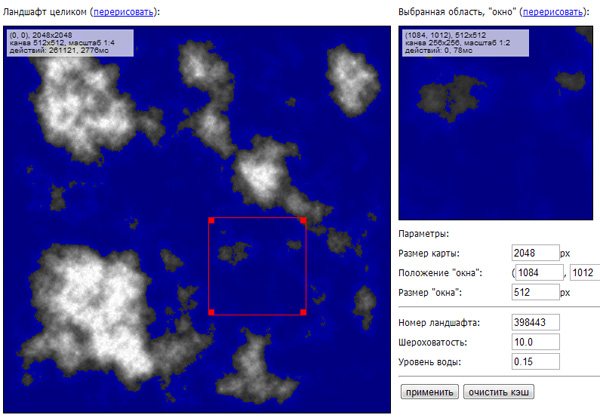

A technique called lazy dynamics
... For those who know what this is about, I think, everything has already become clear, for those who are ignorant of the issue, I will explain. We "turn" the whole process inside out - instead of starting with large squares and going down to each pixel, we accept a request of the form "find out the height at point (x, y)" and go up further: our point, as we know, was obtained by averaging four other points and a random shift. The most difficult thing is to understand what these 4 points were. After we understand this, it will be enough for us to repeat the query "find out the height", but for each of these points. These queries, in turn, will rise one level higher - and so on, until they reach the very top, to the corner points of the map (for me, like points outside the map, they are equal to 0.0). In the source, it all looks something like this:
function val (x, y, v) {if (typeof (v)! = ‘undefined’) data = Math.max (0.0, Math.min (1.0, v)); else {if (x <= 0 || x> = size || y <= 0 || y> = size) return 0.0; if (data == NULL) {// We'll come back to this block later. base = 1; while (((x & base) == 0) && ((y & base) == 0)) base << = 1; if (((x & base)! = 0) && ((y & base)! = 0)) squareStep (x, y, base); else diamondStep (x, y, base); } return data; }} function displace (v, blockSize, x, y) {return (v + (randFromPair (x, y, seed) - 0.5) * blockSize * 2 / size * roughness); } function squareStep (x, y, blockSize) {if (data == NULL) {val (x, y, displace ((val (x - blockSize, y - blockSize) + val (x + blockSize, y - blockSize) + val (x - blockSize, y + blockSize) + val (x + blockSize, y + blockSize)) / 4, blockSize, x, y)); }} function diamondStep (x, y, blockSize) {if (data == NULL) {val (x, y, displace ((val (x - blockSize, y) + val (x + blockSize, y) + val (x , y - blockSize) + val (x, y + blockSize)) / 4, blockSize, x, y)); }}
The main thing is to memorize (and add to some cache) all the heights that we have already calculated on the fly. This will allow us not to do the same thing over and over again. Actually, even having calculated the first point in our "window", we simultaneously recognize a number of other points that also belong to this "window". In fact, having run through all the points of the "window", we will not do so many unnecessary operations - although their exact number strongly depends on whether the "window" (its upper left corner and size) was aligned to powers of two.
As already mentioned, there are several magic lines in the algorithm - here they are:
base = 1; while (((x & base) == 0) && ((y & base) == 0)) base << = 1; if (((x & base)! = 0) && ((y & base)! = 0)) squareStep (x, y, base); else diamondStep (x, y, base); This determines whether the current point is the center of a square or a rhombus and how big this shape is. To be honest, this code was written simply on a whim, I cannot give its exact mathematical justification. We simply find the least significant bit that is nonzero at least in one of the coordinates - it will be the desired size. And to determine whether the figure was a square, we check that both coordinates had this bit set. Both coordinates are zero-indexed here.
And finally, an unexpected pitfall: a pseudo-random number generator. In my code, unusual requirements were imposed on it: for each point (x, y)
you always want to get the same random number, and do it quickly. Many programming languages in the random number generator have the ability to specify the so-called. "Seed", on which the entire next sequence of generated numbers will depend (JavaScript does not have this, but it has an implementation of the common Mersenne vortex). The problem is that the sequence does not suit us - when we shift the window (and clear the cache), we will come to one point from a completely different side and the random shift will become different. We want a static landscape, no matter what conditions we consider it. An attempt to initialize the Mersenne vortex each time with a "grain" depending on both coordinates failed: its initialization takes too long.
After some thought, I came to the conclusion that a quick way to transform two coordinates into a number that would have little correlation with them is, in principle, impossible. In the end, I settled on such a function, which gives acceptable results due to the repeated taking of numbers in simple modules:
function randFromPair (x, y) {for (var i = 0; i <80; i ++) {var xm7 = x% 7; var xm13 = x% 13; var xm1301081 = x% 1301081; var ym8461 = y% 8461; var ym105467 = y% 105467; var ym105943 = y% 105943; y = x + seed; x + = (xm7 + xm13 + xm1301081 + ym8461 + ym105467 + ym105943); } return (xm7 + xm13 + xm1301081 + ym8461 + ym105467 + ym105943) / 1520972.0; } In addition, it was possible to easily add a "global grain" to this function, which defines the entire landscape as a whole, and because of taking the remainders, its returned values turned out to be fairly evenly distributed over the range [0, 1). However, I'm sure you can come up with a faster, elegant solution - you can consider this as "homework" in this article. 

Landscaping elements
Briefly about what can be used to decorate a summer cottage, courtyard, or garden plot. There are many elements, there are even more varieties of them. One of the favorite types of recreation is kebabs or barbecues. And a place is necessarily allocated for this zone. Immediately after determining the place for the house, they often decide where to put the gazebo, terrace, pergola.
Moreover, the presence of a veranda near the house was never the reason why they refused the gazebo or terrace. In this case, the veranda is made closed, and the gazebo is made open. In one they spend time in winter, in the other in summer. Sometimes they put a canopy and or a modern pergola instead. Not the one that only supports plants, although there may be such, but precisely the structure along which the plants climb. After all, such a structure is one of the best decorations of the site.
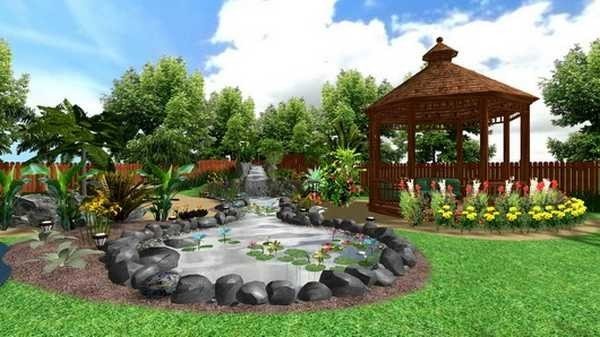

A gazebo and a pond are favorite and brightest ways to decorate a summer cottage or suburban area
An equally popular element of landscape design is artificial reservoirs. They are also made in dachas, in the garden, in the courtyard of the house. The shape, size, type of organization - everything can be different: from mini ponds to quite solid ponds in several cubes in volume and a decent water mirror.
A favorite trick of many designers is to make a trickle. Ideally, if there is a key or a natural stream, but if not, it can be organized. This is not difficult if you have a pond that will be supplied with water. From him, a trickle can run into the garden or garden. This is both beautiful and practical: the irrigation system will be an element of your design, and not pipes that you have to hide in some way. This idea is especially easy to implement on slopes. Even if it is small - only a few degrees, you can make good use of the natural relief. Read how to make a waterfall on a site here.
By the way, the garden can also be decorative, and it is not at all necessary to hide it. True, greenhouses will not become a decoration of the site anyway, but they can be located behind the trees.
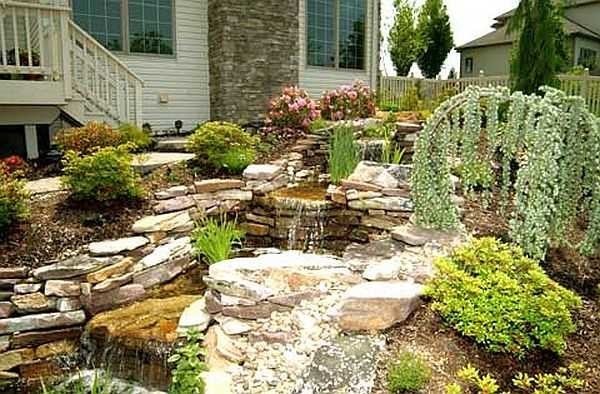

The stream - natural or artificial - looks very beautiful
Between these and other buildings and zones, places are planned for flower beds, flower beds, alpine hills, rockeries, rock gardens, etc. Their shape, size, type of enclosure, species composition of plants and their planting scheme are determined. It is clear that without experience it is not easy to do this and there will be a lot of rework, but it is important to start somewhere. Changes in the plantings are made almost constantly, so you will create landscape design with your own hands for more than one year, and not even three: after all, you will also use perennials, and they grow slowly.
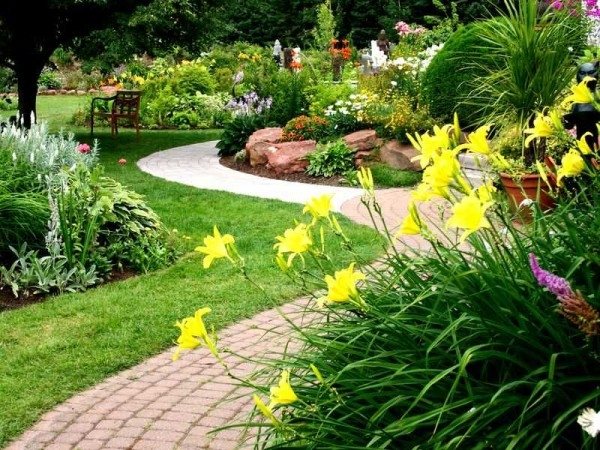

Beds, flower beds, curbs, rockeries, slides and garden paths are what else you can use to decorate
Paths should be laid between all areas and buildings. Their design, not least of all, forms the appearance of a garden, a summer residence. And in general, landscape design is created in many ways from little things. Somewhere there is a small bench, somewhere a garden sculpture, a rocking chair, a flowerpot with flowers, a rockery, a pond, a hammock hanging, beautiful lighting, site lighting, etc. And all this as a whole is the design.
Our Garden 3D Pro
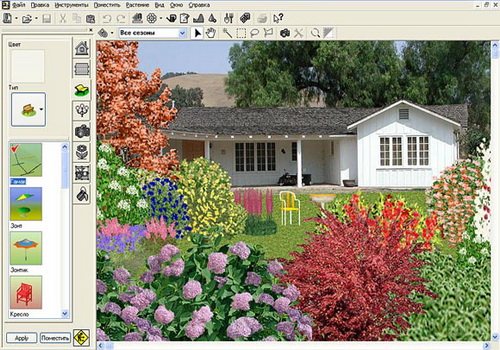

A very successful software product of Russian developers. The best 2D planning, great graphics, quick creation of projects with reference to plants, easy to learn. Many different facilities, from gazebos to tennis courts. No compatibility, i.e. there is no import / export of third-party objects, but this is not necessary, since there are enough of them.
There is, however, some curvature of the product. For example, in order to create an irregularly shaped pond, you have to superimpose several ovals and squares on top of each other. In PhotoShop or similar ace it is much easier, build a polygon of irregular shape and fill it with the required color. Although, if you get used to it, it does not cause any difficulties.
Huge plant base.More than 5000 species, with the ability to select and filter by criteria, as well as add and edit.
Dignity
Best 2D view, huge plant database, add and edit options.
disadvantages
Weak 3D graphics, no import / export. The program is designed for high-quality planning and display in 2-dimensional form. For the designer himself to understand where he is growing. There is no need to flip through tons of books, remembering what to plant in moist soil in the shade. It is enough to make a selection from the database, with certain criteria and that's it.
Website:
Plot with a slope
On the one hand, the landscape design of a site with a complex relief is technically more difficult: there are more engineering structures, the relief needs to be taken into account. But on the other hand, it will look definitely out of the box, since the solutions are all individual.
With a fairly large slope, the principle of decorating terraces is used. The slope is divided into zones, on the low side of which retaining walls are installed. Thanks to them, the surface in some zone - up to the next wall - is leveled. This is due to the fact that part of the soil is transferred.
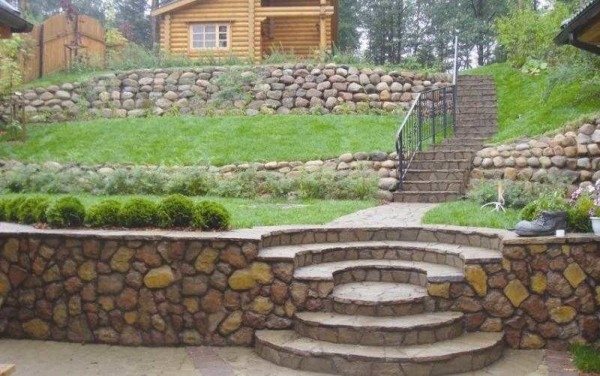

Slope leveling with retaining walls
The terraces themselves are unusual, and they can also be decorated beautifully. For example, make the masonry from rubble stone, and in between plant creeping and low-growing plants, plant lawn grass. They will decorate the wall, as well as anchor the soil with roots.
Technical highlights
The height of the retaining walls is usually no more than a meter, the maximum is 1.2 m. They are erected from monolithic reinforced concrete, they are trimmed with stone on top, and embankments are made. A foundation is required for each such wall. Usually - reinforced tape. With a wall height of up to 60 cm, a sufficiently compacted crushed stone pillow with a depth of 20 cm is sufficient as a support, with a wall height of 70 cm, the foundation should have a depth of at least 60 cm, with a height of 1 to 1.2 meters, the foundation depth should be at least 70 cm.
Based on the requirements for foundations, the lowest costs for the construction of retaining walls with a height of up to 60 cm. If the slope is not very steep, try to break the slope into sections with such a difference in height. And keep in mind that rectangular terraces, although easier to do, from a design point of view, this is the worst option, which is almost impossible to make harmonious. For examples of terracing and decoration, see the photo gallery.
Laying without mortar of large stones looks great Steep section - short terraces For a small drop, the wall may have an unequal height Using the slope for arranging a stream and waterfalls - a classic technique that does not lose its relevance Option how to arrange a slope in front of a house Explicit division into two levels is difficult technically, but aesthetically interesting On a small slope, it may be enough to plant plants, if you, of course, are satisfied with the garden on the slope If the house and the plot are decorated in a simple style, then the retaining wall is finished with appropriate materials Decoration with rubble stone Decoration of the retaining wall with torn stone
Creation of a design concept
This stage of work is the most interesting and creative, it is on this stage that the main design concept is formed. Namely, the style for the design is determined, the material and the corresponding plants are selected. All ideas and ideas are transferred to the paper, the sizes of details and plant forms are worked out and fit in. In this case, it is worth considering the following:
- the growth rate of a particular plant;
- maximum height and width of plants;
- acceptable neighborhoods among cultures.
To create landscape design, you should first choose simpler, but beautiful plants. It will be quite difficult for a novice gardener to care for and grow exotic crops. Experts recommend opting for such plants as:
- juniper;
- thuja, pine plant species;
- hawthorn;
- barberry;
- viburnum;
- varieties of tree peonies;
- chrysanthemums;
- roses of different types;
- garden yucca;
- primrose;
- lupine.
And this is not the whole list of acceptable plants for a beginner, which will help you create an unusual beautiful design on your site. Caring for these plants is quite simple and will allow you to see your work in all its beauty in a short time.
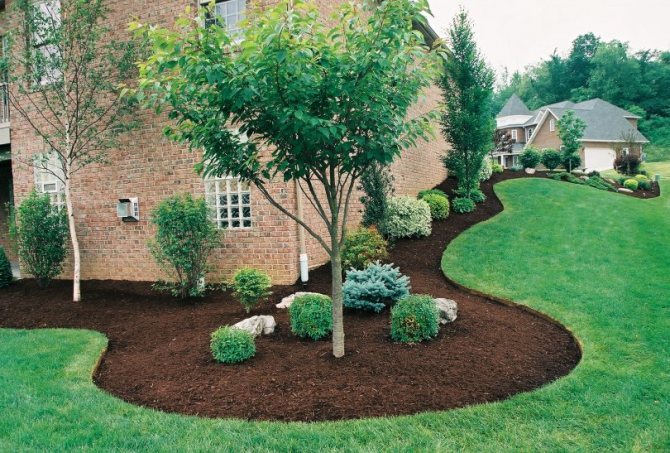

First, choose plants that need minimal care.
When choosing materials, you should give preference to more natural and environmentally friendly products - these are wood, stones and gravel of different sizes.
It is important to keep the work in perspective, since most plants are long-term and planning is done for more than one season. Therefore, it is required to take into account all the nuances and, first of all, it is necessary to think over the color scheme of the project.
Small plot garden design
If the yard near the house or the summer cottage is small, and even of the correct shape - square or rectangular - the fence is most likely visible from any point. The feeling is like in a box. You can eliminate it if you close the fence with plantings. But they should not grow in a line that repeats the shape of the fence, but in smooth, curved curves or groups that go into the lawn. Plants can be interspersed with shrubs, rose gardens, you can put a corner gazebo or highlight some area that violates the correctness of the lines.
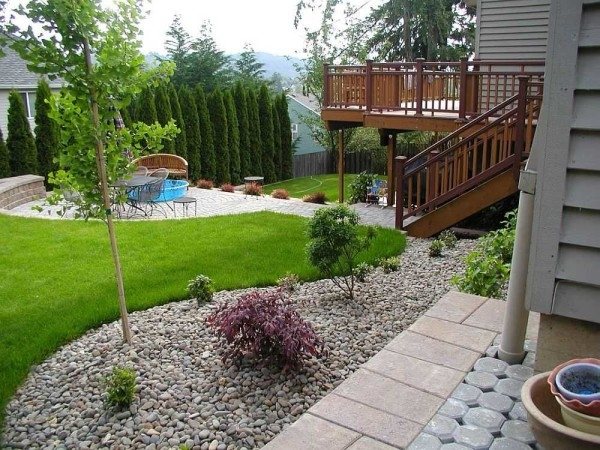

Covering the fence with tall trees is a good idea, but it is better to plant them in groups and of different species.
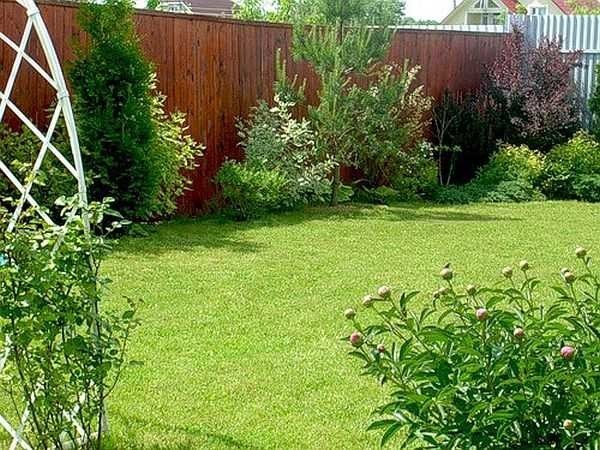

The trees will grow slightly and the site will appear wider
Another option that allows you to turn the fence into a decorative element: allow climbing plants to turn it into a green wall, and plant low plants with rounded crowns nearby. If the plants curl along supporting structures, it is better to make their tops non-linear. Everything will look even better this way.
Another option is a hedge. To grow it, of course, for a long time, although fast-growing plants can be appropriate, in particular, for a quick effect for several years, use willow. You can weave a fence from its young branches, but it takes root almost always, sprouts and turns green in a few days.
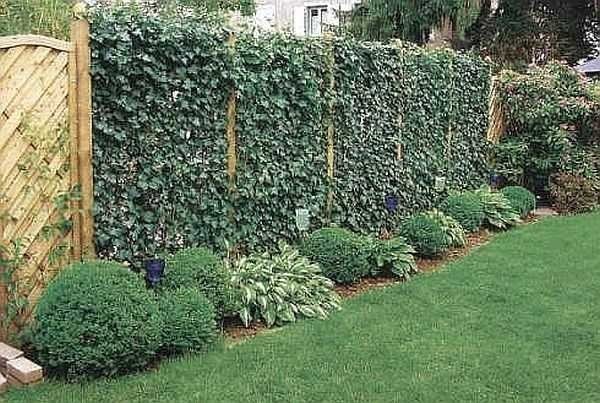

Such a wall is much more decorative than even the most beautiful fence.
When decorating a small space, straight paths are strictly prohibited. They make objects optically closer, which we do not need at all.
Multilevel planning greatly expands the boundaries. This is the case when the slope is preferable: 6 acres look like a larger area if there is a difference in elevation. If the cottage or yard is small and flat, you will have to do zoning artificially. Alpine slides and raised flower beds and flower beds will help with this.
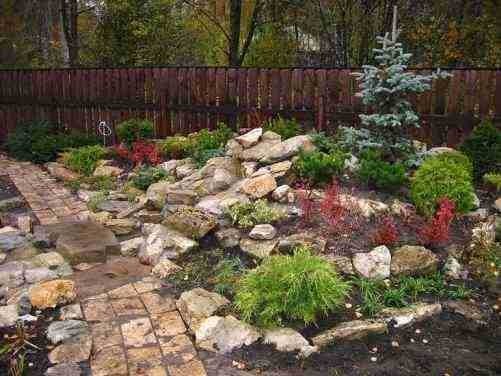

Raised flower beds, rockeries and slides will help to visually expand the space
There are some restrictions on landscaping. Do not plant trees with large crowns. Not only will they shade almost your entire site over time, it will appear even smaller. Small trees, shrubs and flowers are what you need to choose from. If you need several tall stands, choose with a pyramidal crown or in the form of a candle. They are unusual for us and look very good.

